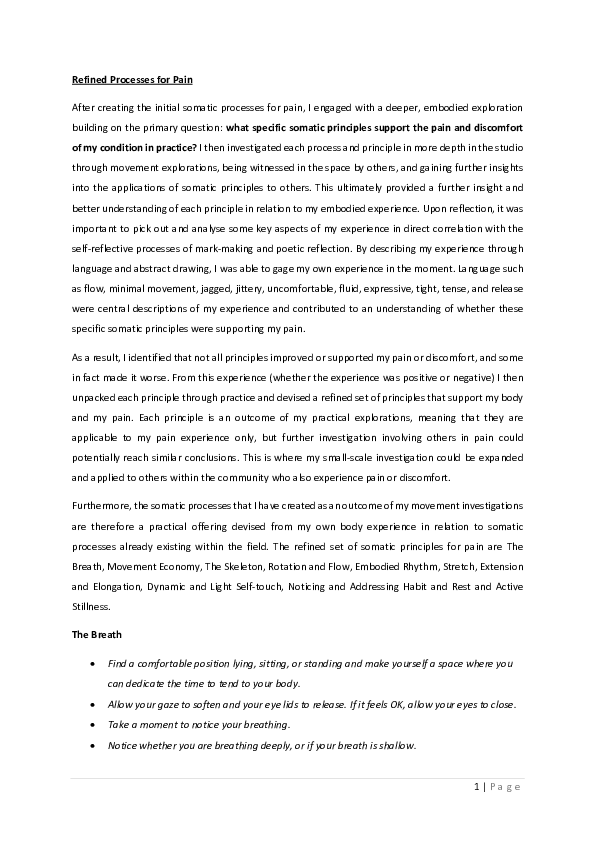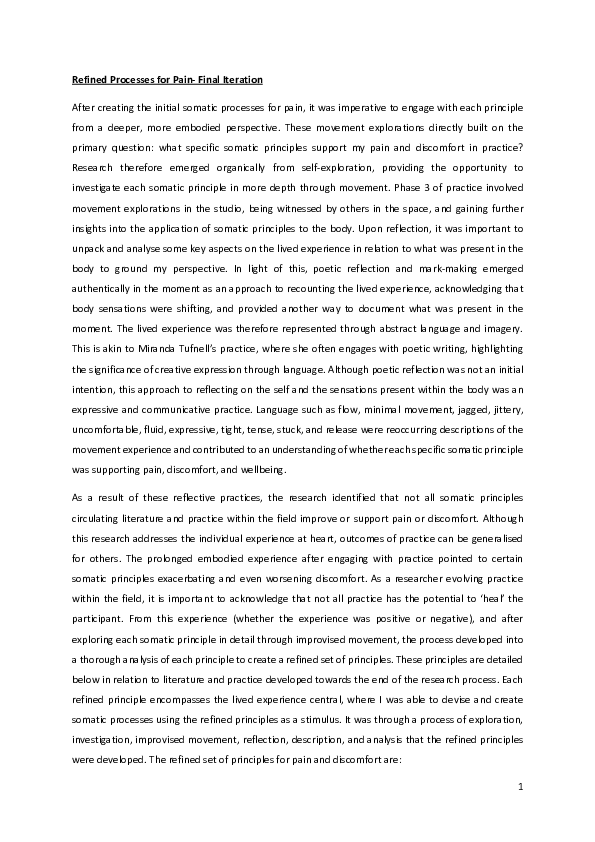PHASE 4: PRACTICE RESEARCH
Refined Somatic Processes- Second Iterations
After creating the initial somatic processes for pain during phase 1 of the practice research process, I engaged with a deeper, embodied exploration building on the primary question: what specific somatic principles support the pain and discomfort of my condition in practice? I then investigated each process and principle in more depth in the studio through movement explorations, being witnessed in the space by others, and gaining further insights into the applications of somatic principles to others. This ultimately provided a further insight and better understanding of each principle in relation to my embodied experience. Upon reflection, it was important to pick out and analyse some key aspects of my experience in direct correlation withthe self-reflective processes of mark-making and poetic reflection. By describing my experience through language and abstract drawing, I was able to gage my own experience in the moment. Language such as flow, minimal movement, jagged, jittery, uncomfortable, fluid, expressive, tight, tense, and release were central descriptions of my experience and contributed to an understanding of whether these specific somatic principles were supporting my pain.
As a result, I identified that not all principles improved or supported my pain or discomfort, and some in fact made it worse. From this experience (whether the experience was positive or negative) I then unpacked each principle through practice and devised a refined set of principles that support my body and my pain. Each principle is an outcome of my practical explorations, meaning that they are applicable to my pain experience only, but further investigation involving others in pain could potentially reach similar conclusions. This is where my small-scale investigation could be expanded and applied to others within the community who also experience pain or discomfort.
Furthermore, the somatic processes that I have created as an outcome of my movement investigations are therefore a practical offering devised from my own body experience in relation to somatic processes already existing within the field. The refined set of somatic principles for pain areThe Breath, Movement Economy, The Skeleton, Rotation and Flow, Embodied Rhythm, Stretch, Extension and Elongation, Dynamic and Light Self-touch, Noticing and Addressing Habit and Rest and Active Stillness.
These processes are also shared as audio recordings in Appendix 8 and were explored with Dr Polly Hudson in the studio during the initial phases of the research process. Initial and final iterations are included to present the development of practice.
PHASE 4: REFINED SOMATIC PROCESSES- REFLECTIONS
Innate curiosity was thus central to the lived experience, where I engaged with conscious questioning whilst moving through my body. As I brought conscious awareness to certain parts of my body that were in discomfort, namely my cervical spine, left shoulder and thoracic spine, I was able to give way to tension and enjoy the experience of moving. By tracking, tracing, and releasing the body I brought about new awareness’s that differed from my usual negative and somewhat restricted experience. Autonomy was central here, where the choice of movement was explored throughout this core phase of practice research, highlighting how my body reacts to movement in the moment.
Each refined somatic process was developed from the lived experience and reflections of the initial somatic processes, highlighting the successive nature of the process. It was imperative to build on what already existed in terms of my experience to delve into my body experience in further detail. Not only was I able to recognise and acknowledge my previous body experience when moving and participating in each process, I was able to carry this forward into phase 4 to inform the development and re-write of each process. The movement films also followed from the initial movement films, which again showcases the developmental process of this practice.

